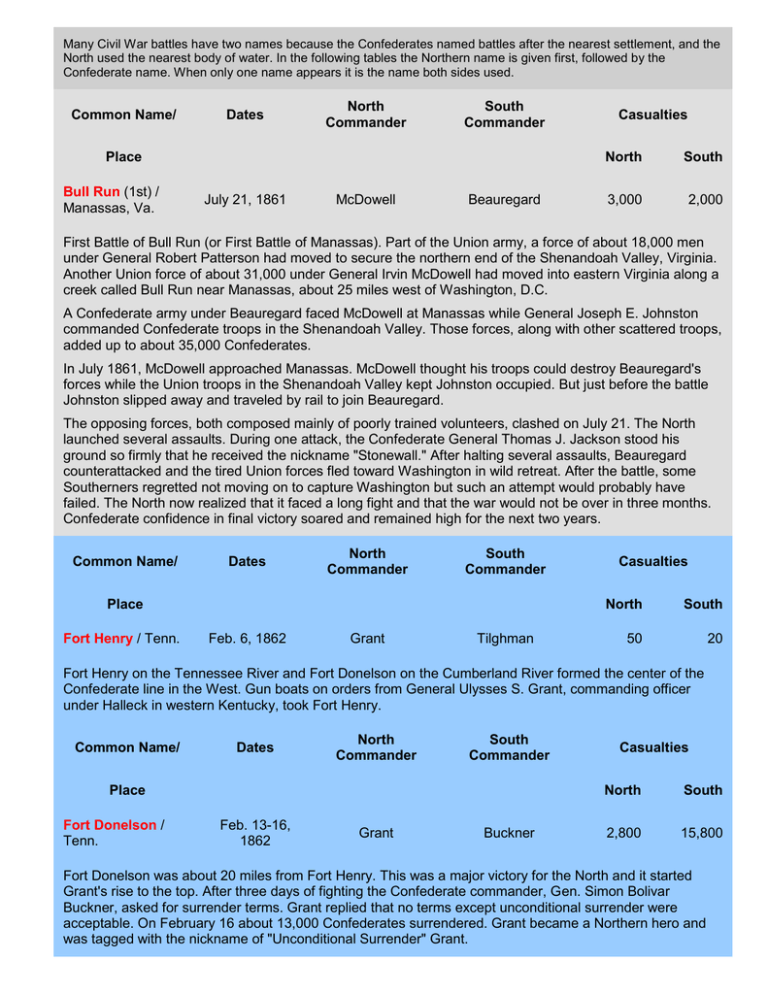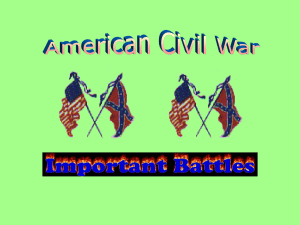Document 14299448
advertisement

Many Civil War battles have two names because the Confederates named battles after the nearest settlement, and the North used the nearest body of water. In the following tables the Northern name is given first, followed by the Confederate name. When only one name appears it is the name both sides used. Common Name/ Dates North Commander South Commander Place Bull Run (1st) / Manassas, Va. July 21, 1861 McDowell Beauregard Casualties North South 3,000 2,000 First Battle of Bull Run (or First Battle of Manassas). Part of the Union army, a force of about 18,000 men under General Robert Patterson had moved to secure the northern end of the Shenandoah Valley, Virginia. Another Union force of about 31,000 under General Irvin McDowell had moved into eastern Virginia along a creek called Bull Run near Manassas, about 25 miles west of Washington, D.C. A Confederate army under Beauregard faced McDowell at Manassas while General Joseph E. Johnston commanded Confederate troops in the Shenandoah Valley. Those forces, along with other scattered troops, added up to about 35,000 Confederates. In July 1861, McDowell approached Manassas. McDowell thought his troops could destroy Beauregard's forces while the Union troops in the Shenandoah Valley kept Johnston occupied. But just before the battle Johnston slipped away and traveled by rail to join Beauregard. The opposing forces, both composed mainly of poorly trained volunteers, clashed on July 21. The North launched several assaults. During one attack, the Confederate General Thomas J. Jackson stood his ground so firmly that he received the nickname "Stonewall." After halting several assaults, Beauregard counterattacked and the tired Union forces fled toward Washington in wild retreat. After the battle, some Southerners regretted not moving on to capture Washington but such an attempt would probably have failed. The North now realized that it faced a long fight and that the war would not be over in three months. Confederate confidence in final victory soared and remained high for the next two years. Common Name/ Dates North Commander South Commander Place Fort Henry / Tenn. Feb. 6, 1862 Grant Tilghman Casualties North South 50 20 Fort Henry on the Tennessee River and Fort Donelson on the Cumberland River formed the center of the Confederate line in the West. Gun boats on orders from General Ulysses S. Grant, commanding officer under Halleck in western Kentucky, took Fort Henry. Common Name/ Dates North Commander South Commander Place Fort Donelson / Tenn. Feb. 13-16, 1862 Grant Buckner Casualties North South 2,800 15,800 Fort Donelson was about 20 miles from Fort Henry. This was a major victory for the North and it started Grant's rise to the top. After three days of fighting the Confederate commander, Gen. Simon Bolivar Buckner, asked for surrender terms. Grant replied that no terms except unconditional surrender were acceptable. On February 16 about 13,000 Confederates surrendered. Grant became a Northern hero and was tagged with the nickname of "Unconditional Surrender" Grant. Common Name/ Dates North Commander South Commander Place Shiloh / Pittsburg Landing, Tenn. April 6-7, 1862 Grant A. Johnston Beauregard Casualties North South 13,000 10,700 The Battle of Shiloh was named after a church on the battlefield. General Halleck had become commander of most Union forces from Ohio to Kansas. He ordered Grant with some 40,000 men to move down the Tennessee River and to wait for Buell to join him. Grant moved to Pittsburg Landing, Tenn., a village about 20 miles north of Corinth. The Confederate co-commanders, Johnston and Beauregard, decided to strike Grant with their army of some 44,000 troops before Buell arrived. The Confederate troops surprised and almost smashed Grant but Grant held his lines and Johnston was killed. The next day, Grant received about 25,000 reinforcements, including some 18,000 troops led by Buell. The Confederate army received only about 700 reinforcements. Grant now used his much larger army to force a Southern retreat to Corinth. By June the Union had control of the Mississippi River all the way to Memphis. Common Name/ Dates North Commander South Commander Place Fair Oaks / Seven Pines, Va. May 31-June 1, 1862 McClellan J. Johnston Casualties North South 5,000 6,000 In Virginia, McClellan landed on the peninsula between the York and James rivers with more than 100,000 men. As McClellan neared Richmond, Johnston launched an attack with early succes but failed to follow through. Johnston was wounded and Lee was given command of Johnston's army which he named the Army of Northern Virginia. Common Name/ Dates North Commander South Commander Place Seven Days / Va. June 25-July 1, 1862 McClellan Lee Casualties North South 15,800 20,100 Reinforced by Jackson's men to about 95,000 men, Lee fell on McClellan in a series of attacks lasting seven days. The advantage shifted from side to side during the battles, but McClellan believed that his forces were hopelessly outnumbered. He finally retreated to the James River, and Richmond was saved from capture. Common Name/ Dates North Commander South Commander Place Bull Run -Second/ Manassas, Va. Aug. 27-30, 1862 Pope Lee Casualties North South 16,100 9,200 Second Battle of Bull Run (or Second Battle of Manassas). Lee moved rapidly northward to attack Pope before McClellan's men could join him. Jackson went in first to attack Pope from the rear but Pope, using McClellan's troops as fast as they arrived, attacked Jackson. When Lee and General James Longstreet joined Jackson, Pope attacked them, but a Confederate counterattack beat Pope's forces back and the Northern troops retreated toward Washington. This was a major victory as the South regained almost all of Virginia. Common Name/ Dates North Commander South Commander Place Antietam / Sharpsburg, Md. Sept. 17, 1862 McClellan Lee Casualties North South 12,500 13,700 The South believed they could gain European recognition by winning a victory in Union territory. In September 1862 Lee invaded Maryland. He divided his force into two divisions sending "Stonewall" Jackson to capture Harper's Ferry while he took the other division to Sharpsburg, a small town on Antietam Creek. Jackson was successful and then turned to join Lee. McClellan launched a series of attacks that almost cracked the Southern lines but then, the last of Lee's absent troops, headed by General A. P. Hill, arrived and saved the day. Lee's force of about 40,000 men suffered heavy losses and had to retreat to Virginia. The North considered Antietam a major victory and Lincoln used the occassion to issue the preliminary Emancipation Proclamation. Common Name/ Dates North Commander South Commander Place Perryville / Ky. Oct. 8, 1862 Buell Bragg Casualties North South 4,200 3,400 Soon after Shiloh, Corinth fell to Union forces and Halleck went to Washington to act as Lincoln's military adviser. He assigned Grant to guard communications along the Mississippi and ordered Buell to capture Chattanooga. Before Buell could advance, General Braxton Bragg, the Confederate commander in Tennessee, suddenly invaded Kentucky. Buell raced to meet him, and the two armies clashed on October 8 at Perryville. Neither side could claim victory, but the South could not afford casualties on the same level as the North. Bragg retreated to Murfreesboro, Tenn. Common Name/ Dates North Commander South Commander Place Fredericksburg / Va. Dec. 13, 1862 Burnside Lee Casualties North South 12,700 5,300 After Antietam McClellan had more fresh troops under him than Lee had left in his entire army yet he allowed Lee to retreat with little interference. Lincoln, seeing this lack of aggression, replaced him with General Ambrose E. Burnside who attacked Lee at Fredericksburg. Lee, with about 73,000 troops, took up a defensive posture along hills called Marye's Heights. Burnside attacked and suffered nearly 13,000 casualties--soldiers killed, wounded, missing, or captured. He retreated and was relieved of command at his own request. Common Name/ Dates North Commander South Commander Place Stones River / Murfreesboro, Tenn. Dec. 31, 1862Jan. 2, 1863 Rosecrans Bragg Casualties North South 12,900 11,700 Lincoln felt that Buell was too cautious and replaced him with General William S. Rosecrans. Rosecrans advanced south from Nashville toward Bragg's army at Murfreesboro on Stones River. The hard-fought battle dragged on from Dec. 31, 1862, to Jan. 2, 1863, when Bragg retreated. The battle had the highest casualty rate of the war, with each side losing about a third of its men. Common Name/ Dates North Commander South Commander Place Chancellorsville / Va. May 1-4, 1863 Hooker Lee Casualties North South 16,800 12,800 General Joseph Hooker replaced Burnside as commander of the Army of the Potomac which numbered about 138,000 men. Lee, with about 60,000, still held the line of defense at Fredericksburg. Hooker planned a frontal diversion while sending other forces to attack Lee's flank. The attack started successfully but then Hooker blinked. On May 1, he withdrew his flanking troops to a defensive position at Chancellorsville just west of Fredericksburg. The next day Lee sent Stonewall Jackson to counter attack which cut the Northern army almost in two. Hooker retreated three days later. During the battle, Jackson was shot accidentally by his own men and his left arm had to be amputated. Lee told Jackson's chaplain: "He has lost his left arm; but I have lost my right arm." Jackson died on May 10. Common Name/ Dates North Commander South Commander Place Vicksburg, Siege of / Vicksburg, Miss. May 19-July 4, 1863 Grant Pemberton Casualties North South 10,000 10,000 Vicksburg was the key city guarding the Mississippi between Memphis and New Orleans. In this brilliant offensive by Grant, followed four days later by the fall of Port Hudson, La., the North cut the Confederacy in two. The North now had control of the Mississippi River and with Kentucky, Western Tennessee, Western Mississippi, and a Navy to blockade sea ports, the North had an encirclement which led to the eventual strangulation of the Confederacy. Further, it effectively settled the war in the West. The South did not have the troops to fight a war in several directions at once. Common Name/ North Commander Dates South Commander Place Gettysburg / Pa. July 1-3, 1863 Meade Lee Casualties North South 23,000 25,00028,000 While Grant was capturing Vicksburg, Lee swung his army up the Shenandoah Valley into Pennsylvania. The Army of the Potomac followed and both armies moved toward the little town of Gettysburg, Pa. Lincoln had put General George G. Meade, a Pennsylvanian, in command of the Union troops. For the first three days of July, a Northern army of about 85,000 men fought a Southern army of about 65,000 in the greatest battle ever fought in the Western Hemisphere. The Northern victory marked a turning point in the war. Lee would never again have the troop strength to launch a major offensive. Common Name/ Dates North Commander South Commander Place Chickamauga / Ga. Sept. 19-20, 1863 Rosecrans Bragg Casualties North South 18,500 16,200 This major Southern victory trapped Rosecrans at Chattanooga but once again the South failed to take advantage. Common Name/ Dates North Commander South Commander Place Chattanooga / Tenn. Nov. 23-25, 1863 Grant Bragg Casualties North South 5,800 7,700 Grant did not lack for supplies and soldiers and turned a precarious situation into a Union win -- putting most of Tennessee into Northern hands. Less than four months later, March 9, 1864, Lincoln named Grant general-in-chief of the Union Armies. Common Name/ Dates North Commander South Commander Place Wilderness / Va. May 5-6, 1864 Grant Lee Casualties North South 17,700 11,000 Under other circumstances this would have been a victory for the South but Grant had superior forces, supply lines, replacement troops, and a boldness to match Lee's. Heavy losses failed to halt his progress southward. Common Name/ Dates North Commander South Commander Place Spotsylvania, Va. Court House May 8-19, 1864 Grant Lee Casualties North South 17,500 10,000 Lee, continuing to fight from defensive positions, inflicted heavy losses on Northern forces but Grant kept storming ahead. Common Name/ Dates North Commander South Commander Place Cold Harbor / Va. June 1-3, 1864 Grant Lee Casualties North South 12,000 1,500 Finally, Grant marched into a buzzsaw. Here about 50,000 attackers faced 30,000 defenders in trenches across a 3-mile line. Northern troops charged in a frontal assault and gunfire cut down 7,000 of them in the first few minutes of the charge. "I regret this assault more than any one I have ever ordered," Grant said. These heavy losses forced a change of tactics. Common Name/ Dates North Commander South Commander Place Petersburg, Va. Siege of June 20, 1864April 2, 1865 Grant Lee Casualties North South 42,000 28,000 Grant now realized that the end of the war was just a matter of time. He launched the siege of Petersburg and pinned down Lee's Virginia army with months of trench warfare while his commanders elswhere finished off other resistance. Common Name/ Dates North Commander South Commander Place Kennesaw Mountain / Ga. June 27, 1864 Sherman J. Johnston Casualties North South 2,100 400 Sherman had started his "march to the sea" but Davis knew he could not sustain victories in direct conflicts with Sherman's army. In spite of this success he replaced Johnston with Hood with instructions to draw Sherman out of Georgia. To achieve that end Hood invaded Tennessee. Common Name/ Dates North Commander South Commander Place Mobile Bay / Ala. Aug. 5, 1864 Farragut Buchanan North Commander South Commander Casualties North South 320 300 The North closed this major Southern port. Common Name/ Dates Place Franklin / Tenn. Nov. 30, 1864 Schofield Hood Casualties North South 2,300 6,300 This fierce battle of Hood's Tennessee campaign failed to draw Sherman from Georgia. Common Name/ Dates North Commander South Commander Place Nashville / Tenn. Dec. 15-16, 1864 Thomas Hood Casualties North South 3,100 6,000 Hood had regrouped after Franklin and managed to motivate his troops for another assault but this Northern victory smashed Hood's army and essentially ended Southern resistance in the West. On September 2, Sherman had conquered Atlanta and by Christmas he occupied Savannah. In September and October Sheridan had ransacked the Shenandoah Valley of Virginia. The next three months were marked by mass desertions of Southern troops who just wanted to go home. By April 1865, it was over when the 2nd Confederate troops gave up Petersburg and Richmond and on April 9, 1865, Lee surrendered to Grant at Appomattox Court House in Virginia. April 14........... Lincoln assassinated. April 26........... Johnston surrendered to Sherman. May 4.............. Confederate forces in Alabama and Mississippi surrendered. May 11............. Jefferson Davis captured. May 26............. The last Confederate troops surrendered.






